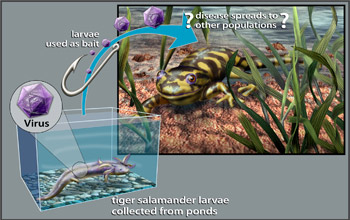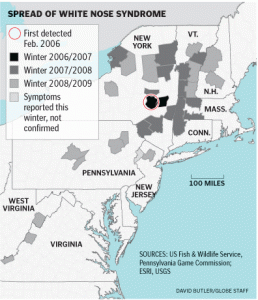TOP STORIES Spring Fishing Season Arrives ... And With It, Amphibian Diseases
Spring Fishing Season Arrives ... And With It, Amphibian Diseases
National Science Foundation - www.nsf.gov
06 Apr 2009
Area: United States
Bait shop trade likely source of pathogen spread in salamanders
Waterdogs, they're called, these larvae of tiger salamanders used as live bait for freshwater fishing.
With tiger salamander larvae, anglers hope to catch largemouth bass, channel catfish and other freshwater fishes.
They may be in for more than they bargained for: salamanders in bait shops in Arizona, Colorado and New Mexico are infected with ranaviruses, and those in Arizona, with a chytrid fungus called Batrachochytrium dendrobatidis (Bd).
10 raccoons discovered with bird flu antibodies
Daily Yomiuri Online - www.yomiuri.co.jp and Associated Press - www.ap.org
07 Apr 2009
Area: Japan
Ten wild raccoons have been found with signs of previous H5N1 bird flu infections, according to a joint study by Tokyo University and Yamaguchi University.
This is the first time mammals in this country have been found with bird flu virus antibodies, which develop as a result of infection. Before the discovery, only birds had been found with bird flu antibodies.
The research team, which presented a paper on its findings at a conference of the Japanese Society of Veterinary Science in Utsunomiya on Saturday, warned that infected raccoons could introduce the virus into chicken farms and noted that countermeasures were needed.
 Sick bats' PR problem could prove to be deadly
Sick bats' PR problem could prove to be deadlyBoston Globe - www.boston.com
06 Apr 2009
B Daley
Area: United States
To a public raised on vampire movies, bats are loathsome, frightening creatures - blind, flying rodents that all carry rabies, suck human blood, and get impossibly tangled in long hair.
None of it is true. But scientists trying to drum up a public outcry - and government funding - to stop a mysterious illness ravaging bat populations from Vermont to Virginia believe these myths are thwarting their efforts. The researchers say they are learning a harsh truth about the public's desire to save animals: Cuteness rules.
Despairing bat biologists want to hire a publicist - a kind of public relations batman - to give bats an image makeover and educate people about the night creatures' ecological benefits.
 Reported Wildlife Mortality Events to the USGS National Wildlife Health Center Updated
Reported Wildlife Mortality Events to the USGS National Wildlife Health Center UpdatedUSGS National Wildlife Health Center
08 Apr 2009
Area: United States
USGS and a network of partners across the country work on documenting wildlife mortality events in order to provide timely and accurate information on locations, species and causes of death. This information was updated on Apr 04, 2009 on the USGS National Wildlife Health Center web page, New and Ongoing Wildlife Mortality Events Nationwide. Quarterly Mortality Reports are also available from this page. These reports go back to 1995.
OTHER WILDLIFE HEALTH NEWS
Photo credit: EcoWorldly
 Madagascar Environment Threatened By Potential Civil War
Madagascar Environment Threatened By Potential Civil War- Large Number Of New Prions Discovered: Scientists Redefining What It Means To Be A Prion
- Animals on the brink of extinction
- Need Wild Bees? Plastic Totes Make A Superb Bee 'Nursery'
- Obey Seeks Millions for Agricultural Earmarks in Federal Budget [CWD and VHS]
- Newcastle Disease Breaks out in Belgium - Bevel, Antwerp - Map It
 and Nieuwerkerken, East Flanders, Belgium - Map It
and Nieuwerkerken, East Flanders, Belgium - Map It 
- Ultra-Rare Shark Caught and Eaten
- Six moose die after being tranquilized
WILDLIFE HEALTH RELATED PUBLICATIONS
Browse complete Digest publications library here.
Avian influenza viruses detected by surveillance of waterfowl in Ireland during 2003-2007
Epidemiol Infect. 2009 Apr;137(4):464-72. Epub 2008 Sep 17.
PJ Raleigh et al.
Sampling for Highly Pathogenic Asian H5N1 Avian Influenza in Migratory Birds in Alaska: Results of 2008 Field Season [progress report]
U.S. Geological Survey and Fish and Wildlife Service. 2009. [free full text available][pdf]
Prion diseases and their biochemical mechanisms
Biochemistry. 2009 Mar 31;48(12):2574-85.
NJ Cobb and WK Surewicz
[The wild bird enigma: what role do wild birds play in the highly pathogenic avian influenza epizootic?][German]
Tieraerztliche Umschau. 2009 Feb; 64 (2): 77-83 [no on-line abstract available]
C Schoene et al.






No comments:
Post a Comment